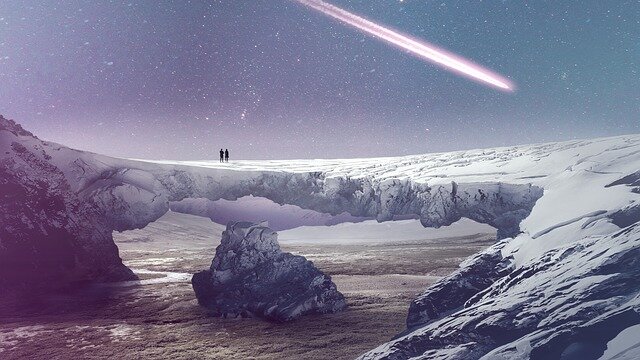Why Don’t We Just Go Find Out If We Can Live There?
One of the challenges space explorers would face is determining the habitability of a planet. Signs of oxygen in the atmosphere don’t mean it is breathable. A breathable atmosphere is likely mitigated by a hostile biosphere or environmental conditions you don’t know about until you arrive.
The ethical problem is how to determine habitability without dooming the explorers. Yes, space explorers and potential colonists would probably be volunteers, assuming they’re all fully informed adults. However, they’d still be faced with the challenge of fully exploring a planet and mapping out the risks without losing so many of their number that they are doomed, they are now too few to survive while waiting for a follow-up ship or having lost their viability as a colony.
If they find that surviving on the planet requires adaptations to it, they’re even less qualified to make the necessary changes to the next generation via genetic engineering or mechanical additions. The moral issues in this case are two-fold. One issue is the ethical quandary of making modifications to the unborn, especially when it is only in the mere hope that the genetic changes will work and the child survive. The second moral issue is that the colonists making the decision are the least able to do so, both from their normal attachments to their children and the low odds they could make the right decisions given limited numbers, expertise and skill. Their odds of success are much lower than if the same project was done on Earth, so they’re condemning a larger than otherwise expected number of children to death, disability and an uncertain fate. How many would either choose not to have children at all or seek to have normal human children, though this almost certainly dooms them to die on an alien planet?
This creates a serious question for potential space exploration and human “adaptation” to said worlds. How do you determine habitability of alien worlds with minimal risk to people? And how do you determine the adaptations necessary for human survival with minimal ethical concerns?
The Habitability Question
I remember a science fiction series where the aliens showed up on Earth one day, rounding up everyone, including the heroine, from a mall. Later on, she learns how the aliens determine the habitability of a planet. They dump a bunch of slaves on it, come back years later, and see if the slaves survived. If all the slaves are dead, it is unfit for colonization. If most of the slaves are alive and healthy, it is habitable. And those slaves are a valuable source of information on the hazards of the planet. It is a cheap, simple solution for a species that doesn’t have the same ethical system we do and space travel that rivals ocean-crossing ships of a century ago.
We will probably send probes with the most advanced artificial intelligences and sensors we can assemble. This won’t prevent disasters that were a hallmark of Larry Niven’s Known Space series. For example, one world was settled because the probe landed during the calm season, though the planet is hit with hurricane level winds twice a year. The colony that formed on a California sized peninsula jutting out of a Venusian atmosphere is downright hospitable compared to that. Well, just that patch of the planet, anyway.
We can alleviate some of this risk by requiring the probe to literally monitor the planet for years. Yet that can’t catch everything, the thousand year “fire time” being but one example. And spaceships and crews are still valuable. Nor does a probe fully identify environmental and biological hazards that the probe won’t encounter precisely because it is artificial.
There is, however, a process that could truly test for such hazards:
- Thaw literal lab rats out of hibernation.
- Ensure that they are sterilized so you don’t muck up the local ecosystem if they escape or mess up later tests by running around the ship.
- Expose them to controlled mixtures of local air, water, soil and plants.
- The AI should record which diseases, pathogens and poisons their bodies react to and study them. If toxins, pathogens and environmental factors we can’t really quantify keep killing them, the planet is not habitable.
- If the rats live, let them die out … and then break out the monkeys.
- Again, ensure sterility.
- Implant them with advanced tracking and recording devices.
- Expose them to the local air, water, soil and plants. Determine edibility, disease factors, and parasites.
- If they live, let them loose on the surface.
- Record what the monkeys do.What comes out to eat them? What do they eat at different stages in its lifecycle that is edible or toxic? How does the local ecosystem react to them? When do they get sick? The exploration of a monkey may reveal a parasite or pathogen that wouldn’t have been exposed by a trundling excavator.
- Track them for their entire lifetime. If monkeys can survive a decade or more without ill effects, you can say the planet is habitable. If there are ill effects, you have the necessary data to guesstimate on human adaptations.
- Tell Earth so it can decide to send colonists.
- If Earth doesn’t reply in a reasonable time frame (a hundred years?), the AI can assume humanity is extinct. Break out the embryos from storage and start raising colonists, or create fertile monkeys to go evolve to become humanity’s replacements.
The Adaptation Problem
The system above provides a direct answer to the question: “Is the planet habitable enough we could just walk off the ship and live there?” The odds of this happening are infinitesimal. The few planets that count as habitable will likely require some sort of genetic modification for humans to live on the surface without protective gear. Sorry, but Star Trek is closer to fantasy than science fiction. The Battlestar Galactica reboot that prized every rare habitable planet they found is closer to reality … minus humanoid Cylons.
An AI could study the environmental effects on the monkeys in the trials already described. We’ll assume that it has a good enough understanding of genetics to identify variations in the population that resulted in better long term odds of survival. The AI can guestimate what genetic alterations could result in better odds of survival. From there, it is simply a matter of trial and error. Assume a lot of error, which is why we’re running these experiments on non-humans.
An AI that genetically engineers monkeys, rears them, ensures they are sterilized, and then releases them isn’t a far cry from the motherships of The Songs of a Distant Earth by Arthur C. Clarke. The difference is that the AI could test hundreds of changes on thousands of subjects to learn what does work before any humans are ever put at risk.
The definition of success is the same as the habitability test – do most of the subjects live a normal life expectancy when left to live on the surface? When that answer is yes, the AI needs to study a different issue in detail. Are the resulting changes to the monkey’s biology something humans would tolerate? The characters in Ben Bova’s Exiles trilogy faced this decision, and they chose generations more of traveling into the unknown at the risk of all their lives over transforming their children into hulks breathing a different atmosphere. Humans certainly wouldn’t tolerate genetic changes that resulted in colonists that were left retarded or insane. If you were OK with less intelligent but well adapted descendant species run around, the genetically-engineered monkeys are the moral alternative.
This is why testing such a system on monkeys would be necessary; you couldn’t get real results from simulations that make assumptions that may be incorrect, and lab rats can’t give you enough information to be certain as to the results in humans.
If the genetically engineered monkeys are within acceptable baselines of intelligence, behavior and physical form, then that data could be sent back to Earth. And Earth could decide whether to send colonists whose children would be modified to these specifications or permit a seed-ship to create children with the identified genetic modifications. Earth-based humans would likely have far more information on the human genetic changes’ end result, and they could recommend other modifications in the process per their ideal outcome. If it takes years to figure out, oh, well, the AI has more time to study the environment.
What About Living Under a Dome?
Why are we talking about genetically engineering humans to adapt to a nearly-habitable world? Why wouldn’t humans show up and live under a dome? The simple answer is: economics.
If you want to live under a dome, you could do it on Mars without the cost of interstellar travel. If you want to live at 1 G and a controlled environment, you could do it on a rotating space station built for a fraction of the cost of building spaceships. And you’d be safer, since a society able to build massive space stations could almost certainly send people back to Earth or other destinations if something goes wrong.
We’d only end up with people living under domes under an alien sky if we sent them with insufficient information, and that’s not something we’d want to do. Even potential colonists wouldn’t want to choose that when they could be living in generation ships going to known habitable worlds where their (mostly?) human descendants would live free.
In short, we’re not going to send humans to known inhospitable worlds. Not when we could build space stations out of asteroids or domes in our own solar system for the same effect at a lower cost and reduced risk to ourselves.

What If There Are Aliens?
We can hope an AI is smart enough to identify alien civilizations. If we can’t design an AI that can figure it out, the aliens intentionally killing all the monkeys or experimenting on them would be clear enough to the AI that the planet isn’t suitable for humans. OK, that’s a sentence I didn’t think I’d ever write.
Yes, this type of situation precludes First Contact with colonists. Conversely, it protects colonists from being wiped out by the aliens, a subject of many science fiction novels. Furthermore, the exploration ship and its AI pose minimal risk to the aliens. Yes, its existence tells the aliens that aliens (to them) exist. But the potential for ecosystem disruption, social contamination and even revealing information we don’t want them to have is far less when it is an AI and whatever life forms it is testing at the time.
If you’re really afraid aliens could and would figure out how to raise humans from genetic material as slaves, have a self-destruct program for the genetic repository. Or the whole ship. And we still solve the ethical dilemma, since an AI nuking itself doesn’t pose the same drama asking a ship full of scared humans to blow themselves up.
******
Photos by foilman  and Michael Hiraeth
and Michael Hiraeth



Comments
Follow the links below to read more that I’ve written.
Tamara Wilhite’s Amazon Author Page
https://www.amazon.com/-/e/B073WNRYHP
Tamara Wilhite on Hubpages
https://hubpages.com/@Tamara Wilhite